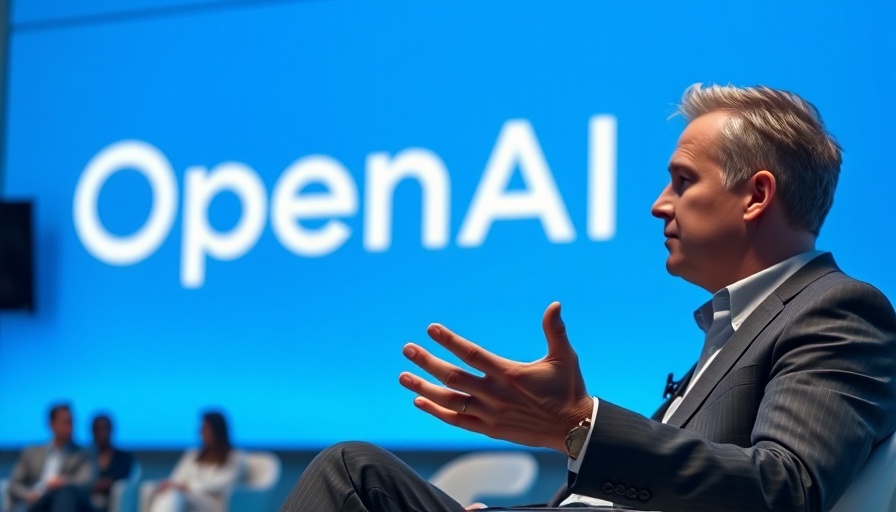
The Challenge of GPU Shortages in AI Development
In a remarkable announcement from OpenAI, CEO Sam Altman revealed that the company has run out of GPUs, a crucial component for its cutting-edge AI models. This shortage has led to the decision to stagger the rollout of their latest model, GPT-4.5. Unlike previous iterations, this new model promises enhanced capabilities in recognizing patterns and generating coherent responses, making it more interactive and 'human-like' than ever before.
Why GPUs Are Essential for AI
Graphics Processing Units (GPUs) are at the heart of modern artificial intelligence development. They are necessary for handling the immense parallel processing requirements of AI algorithms. This recent hiccup illustrates the growing pains of AI giants like OpenAI, as demand for GPUs surges in a world increasingly reliant on artificial intelligence.
According to sources, the latest model, GPT-4.5, is particularly demanding, leading Altman to state that OpenAI is indeed facing substantial limitations in compute capacity. As a result, they are looking to add tens of thousands of GPUs shortly, illustrating just how intensive the needs are for such advanced systems. This situation raises questions about sustainability and planning in a rapidly expanding industry.
Now More Than Ever: The Importance of AI Infrastructure
The competition for GPUs has intensified considerably, resulting in shortages and inflated prices. Companies like CoreWeave, which previously thrived in supplying GPUs to various AI ventures, are witnessing both profitability and significant operational costs—a delicate balance to maintain in the fast-paced AI landscape. They recorded stunning revenues of $1.92 billion in 2024, yet net losses exceeding $800 million indicate how much investment is needed to stay relevant in this industry.
With major players like Microsoft being responsible for over 60% of CoreWeave’s revenue, this single-client dependency poses a risk if such partnerships falter. Perhaps this market dependency illustrates a broader trend, where tech giants are investing heavily in their data centers—a strategic move to ensure they control their own resources in this GPU race.
Future Outlook: What’s Next for AI Companies?
The impact of these GPU shortages is expected to ripple through the AI sector, influencing timelines and capabilities of emerging technologies. As firms expand their hardware capacities and ramp up production of proprietary chips, the horizon looks promising but fraught with challenges. For instance, OpenAI is also looking towards collaborations for developing their own chips, a strategy that may help reduce reliance on third-party suppliers, particularly Nvidia, whose GPUs are in high demand.
Moreover, as the AI market is predicted to expand, announcements from other companies regarding their ambitious plans, such as Microsoft's $100 billion AI supercomputer project, suggest that further innovation is inevitably on the way. However, it also invites serious scrutiny on sustainable growth practices and ethical considerations of deploying such technologies.
The Bigger Picture: Economic Implications of AI Development
The economic landscape tied to AI innovation is closely intertwined with technological advancements. Both OpenAI’s impressive valuation and the funding raised by companies like Anthropic indicate a booming market, but also highlight the competitive nature of resource acquisition. The staggering costs associated with deploying these models prompt discussions about profitability and the pricing of AI services, ensuring that not just the big players thrive. As AI continues to evolve, the potential for smaller developers to carve out space in this ecosystem remains a critical topic.
Additionally, issues linked to data privacy and content regulation have come to the fore, examining how AI influences user experiences across platforms. The earlier discussions of AI's potential to create new income streams for publishers stand juxtaposed against hard realities showing that AI-driven search engines bring 96% less referral traffic compared to traditional search methods. A critical evaluation of these facets is essential for understanding AI's role moving forward.
Take Action: Exploring the AI Landscape
For those passionate about artificial intelligence, staying informed about these developments is crucial. Whether you're a hobbyist, professional, or someone curious about AI's future, understanding these trends equips you with the insights needed to navigate this dynamic field effectively. The stakes are high, and the continued evolution of AI, driven by technological advancements and societal implications, beckons every contributor—big and small—to engage in the discussion.
 Add Row
Add Row  Add
Add 




 Add Row
Add Row  Add
Add 

Write A Comment